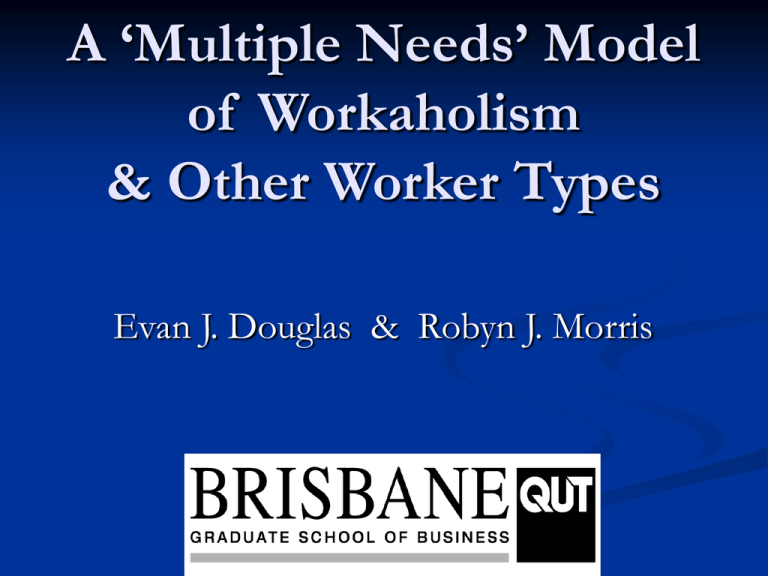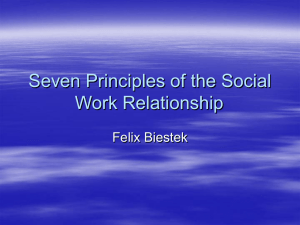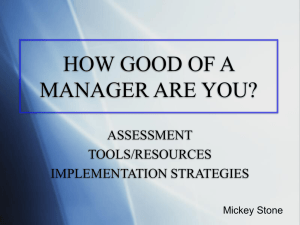Work Orientation
advertisement

A ‘Multiple Needs’ Model of Workaholism & Other Worker Types Evan J. Douglas & Robyn J. Morris Introduction Why do people work? Why do some work harder than others? Working hard is ‘good’ for business profitability, national income, global competitiveness, etc. But ‘Workaholics’ have negative impacts on themselves, co-workers, family, community, etc. They prefer to work, but they usually experience low work enjoyment ‘Work Enthusiasts’ also work hard They are averse to work itself, but work hard because they gain high levels of work enjoyment. Previous Research Spence & Robbins identified 6 worker types, based on their ‘triad’ of characteristics: Work Involvement Psychic Drive to work Inner need to work Work Enjoyment The extent to which a person works hard The satisfaction the person gains from working Buelens & Poelmans (2004) identified 2 more… The Worker Typology Worker Type Involvement Drive Enjoyment Enthusiastic Workaholic High High High Workaholic (Work addict) High High Low Work Enthusiast High High Low Low High Low Alienated Professional Low High High Disenchanted worker Low High Low Relaxed worker Low Low Low Low High Low Reluctant Hard Worker Disengaged worker Focus on Consequences Research has focused on the ‘hard worker’ types Those with high work involvement Focus has been largely on the consequences of working hard Hard workers may cause negative impacts on Their own health Co-worker job satisfaction Business productivity But so might others (who do not work very hard) The Focus of this Paper This is a conceptual paper, to identify and clarify the motives for working (or not working) hard Will not address the negative (or positive) impacts of workaholism And why people gain more (or less) work enjoyment Conceptually separate issue (externalities) Will treat ‘hard work’ as long hours and/or high intensity of work Work Effort = Hours x Intensity Research Questions What causes people to work harder, or less hard? Only reason offered so far is ‘psychic drive’ What causes people to gain greater (or lesser) work enjoyment? Can we offer a theory that explains each of the worker types? Why they have high (or low) work involvement; Why they have high (or low) work enjoyment; and Why they have higher or lower total satisfaction. What causes people to work harder? They want more income They don’t enjoy their non-work time Social networking, good managers, good co-workers Tangible and intangible perquisites (perks) of work They have perfectionist tendencies Lack of leisure activities, friends, toys to play with… They enjoy the non-monetary aspects of work To buy goods and services Getting things perfect requires working longer They want to achieve success or specific targets Achieving targets takes longer than not achieving them People work to satisfy needs… Need for goods and services (+) Need for leisure (-) Work Orientation Need for perfectionism (+/-) Perquisite Orientation Need to work (+/-) Leisure Orientation Need for perquisites associated with the workplace (+) Economic Orientation Perfectionist Orientation Need for achievement (+) Achievement Orientation What causes people to be happier? Having and enjoying goods and services Having and enjoying their leisure (non-work) time Work Orientation Getting closer to perfection Perquisite Orientation Having the opportunity to work Leisure Orientation Having and enjoying perquisites at work Economic Orientation Perfectionist Orientation Achieving targets and success Achievement Orientation Economic Orientation Defined as ‘the strength of preference for income’ Income is generally related to productivity, which is generally related to time spent working… Expectancy theory (Vroom, 1964) It encompasses the preference for future income This preference is derived from the strength of preference for goods and services (i.e. materialism) Some strongly prefer material things, others less so… E.g. One might work harder to gain a promotion Also encompasses the preference for financial security E.g. One might work harder to build a bigger ‘nest egg’ Leisure Orientation Defined as ‘the attitude of an individual to leisure’ For simplicity in this paper, Leisure = Non-work The strength of preference for non-work time Is derived from the strength of preference one has for High and low preferences for leisure… Time spent by oneself, relaxing, sleeping Time spent with family Doing chores Playing with one’s ‘toys’ Participating in the community Involvement in sport and recreation, etc. Depend on your preferences for the above components The income-leisure trade-off Only 24 hours in a day The Income-Leisure Trade-off Income S W3 Y3 W2 I3 Y2 W1 I2 Y1 0 I1 E1 E2 E3 Work Effort Different Work-Effort Supply Curves Y (a) Y (b) Y S (c) S S E E 0 Emax 0 Emax E 0 Emax Changed Economic or Leisure Orientations Income S’ S I” B Y’ I’ I A The ‘wall’ Y2 I2 0 C E2 E’ E” Emax Work Effort Perquisite Orientation Perquisite Orientation is defined as the strength of preference for the non-monetary benefits associated with working Perks are both tangible & intangible Some perks are negative Physical things – office, car, location, etc. Social interaction with co-workers, fun at work, good management/leadership, achievement, etc Irksome co-workers, traffic congestion, etc Net perks = Perks – Irks This is what we mean when we say ‘perquisites’ Perquisite orientation shifts the Supply Curve outward Work Orientation Defined as the individual’s attitude to work per se Economists traditionally expect this is to be negative; i.e. workers have an aversion to work. Calvinistic ‘work ethic’ assumes that for some people this attitude is positive: An inner psychic need to work Work itself gives satisfaction This means the indifference curves will be positively sloping in income-work effort space The Range of Work Orientations (a) Work Preference (b) Preference & Aversion (c) Work Aversion Income Y S1 Y S2 Y S3 I* 0 Ewall E 0 Ewall E 0 Ewall E The Workaholic’s Supply Curve I8 Income I6 I5 Y3 S I7 W2 I4 I3 Y2 B A C I2 I1 0 E Emax Work effort Perfectionist Orientation Defined as the strength of preference for achieving perfect outcomes at work Some people have stronger preference for perfectionism than others Has been associated with workaholism Spence & Robbins (1992) Scott, Moore & Miceli (1997) May cause utility or disutility at work Satisfaction from achieving perfect outcomes Frustration with not getting things perfect Therefore, may shift the supply curve out, or back. Achievement Orientation Defined as the strength of one’s preference for achieving desired results at work Completion of projects on time, on budget Winning formal or informal competitions Gaining market share, increased profitability, etc Need for achievement has long been recognized as underlying people’s motivation to excel McClelland (1953) Scott, Moore & Miceli (1997) Types of Work Enthusiast TYPE Work effort Work Work orient’n enjoy. Econ orient’n High Low High High Low-Leisure Work High Enthusiast Low High Perk-loving Work Enthusiast High Low High Achieving Work Enthusiast High Low High Materialist Work Enthusiast Leisure orient’n Perquis. orient’n Achieve orient’n Total satisf ’n High Low High High High High High Further Speculations TYPE Work effort Work Work orient’n enjoy. Econ orient’n Leisure orient’n High Low High High Low? Low-Leisure Work High Enthusiast Low High Low High? High Perk-loving Work Enthusiast High Low High Low? High High Achieving Work Enthusiast High Low High Low? High? Materialist Work Enthusiast Perquis. orient’n Achieve orient’n Total satisf ’n High High High Other Worker Types Work hours Inner Drive Enjoyment Leisure orientation Perquisite orientation Enthusiastic workaholic Hi Hi Hi ? ? Hi Work addict workaholic Hi Hi Lo ? ? Lo Reluctant hard worker Hi Lo Lo Hi ? ? Alienated professional Lo Hi Hi ? Hi ? Disenchanted worker Lo Hi Lo ? ? Lo Relaxed worker Lo Lo Hi ? ? Hi Disengaged worker Lo Lo Lo ? ? Lo Worker types Income orientation Some Further Speculations Work hours Inner Drive Enjoyment Leisure orientation Perquisite orientation Enthusiastic workaholic Hi Hi Hi Hi? Lo? Hi Work addict workaholic Hi Hi Lo Lo? Lo? Lo Reluctant hard worker Hi Lo Lo Hi Hi? Lo? Alienated professional Lo Hi Hi Lo? Hi Hi? Disenchanted worker Lo Hi Lo Lo? Hi? Lo Relaxed worker Lo Lo Hi Lo? Hi? Hi Disengaged worker Lo Lo Lo Lo? Hi? Lo Worker types Economic orientation Summary and Conclusions Six main motivations for work have been identified and clarified: Four types of Work Enthusiasts are identified: Income, Leisure, Perquisite, Work, Perfectionist, and Achievement orientations Materialists, Low-leisure, Perk-loving, High-Achieving Explanations offered for the high/low levels of work involvement and/or work enjoyment in the other worker types. A series of propositions offered for empirical testing Thank you!






